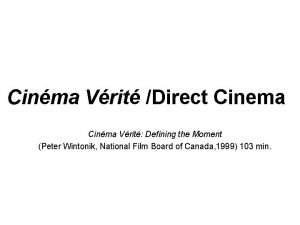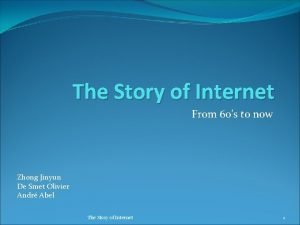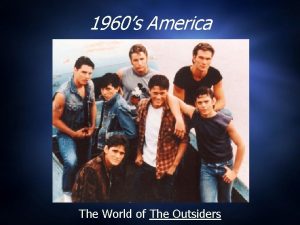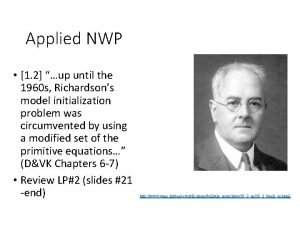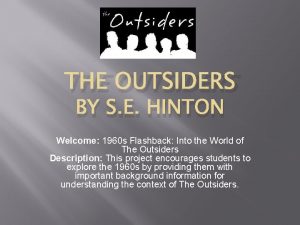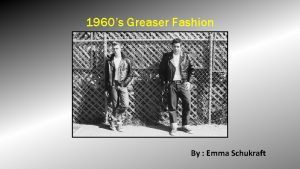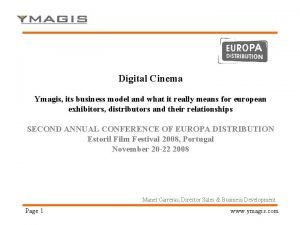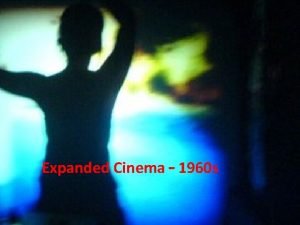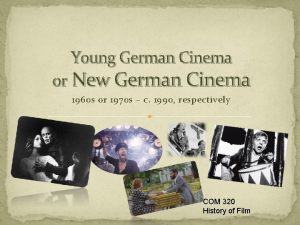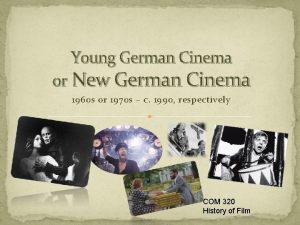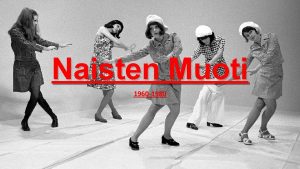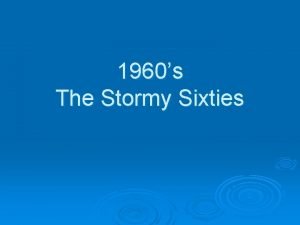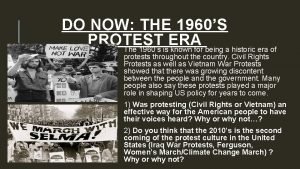THE 1960S THE 1960S Cinema in the 1960















- Slides: 15

THE 1960’S

THE 1960’S • Cinema in the 1960 s reflected the decade of fun, fashion, rock • • • 'n' roll, tremendous social changes, ETC. Some of the happenings/changes of the 1960’s included… Death of Marilyn Monroe First T. V. broadcast in color Beatlemania, the Beatles 'invaded' US First man on the moon Coming about of Martin Luther King and the Civil Rights movement.

THE 1960’S • 1963 was the worst year for US film production in fifty years (there were only 121 feature releases). And the largest number of foreign films released in the US in any one year was in 1964 (there were 361 foreign releases in the US vs. 141 US releases). • With movie audiences declining due to the dominance of television, major American film companies began to diversify with other forms of entertainment: records, publishing, TV movies and the production of TV series

THE 1960’S • In July of 1961, TWA Airlines began the first regular in-flight movies in first-class during a NYC to LA flight, with a Bell and Howell projector aimed at a screen to show Love Possessed (1961), starring Lana Turner. • In September of 1961, Saturday Night at the Movies premiered on NBC with the first wide-screen comedy, “How to Marry a Millionaire” (1953) - it marked the start of the trend to broadcast Hollywood movies on TV. • Separate awards for Black and White and Color Cinematography were eliminated by AMPAS, because most films were being made in color.

Financial Difficulties Within the Film Industry • The major studios financed and distributed independently- produced domestic pictures. And made-for-TV movies became a regular feature of network programming by mid-decade. The average ticket price was less than a dollar, and the average film budget was slightly over one and a half million dollars. • Studio-bound "contract" stars and directors were no longer. And most of the directors from the early days of cinema were either retired or dead. Some of the studios, such as UA and Hal Roach Studios, had to sell off their backlots as valuable California real estate (for condominiums and shopping centers). • To aid the tourist industry and create another attraction, in 1960, the Hollywood Chamber of Congress inaugurated the Hollywood Walk of Fame. • The first star, placed on February 9, 1960, was for Joanne Woodward. However, by the mid-70 s, Hollywood was better known for its adult bookstores, prostitutes, and run-down look.

The Birth of the Multiplex and the Demise of Theatre Palaces • Stanley H. Durwood became the father of the 'multiplex' movie theater in 1963 when he opened the first-ever mall multiplex, composed of two side-by-side theaters with 700 seats at Ward Parkway Center in Kansas City. • Meanwhile, the creation of and flight to the suburbs, the studios' divestiture of their theatre holdings after 1948, and the impact of television in the 1950 s meant the demise and razing of the benchmark, downtown movie palaces of the 20 s.

THE CLEOPATRA DISASTER • The much-heralded Joseph L. Mankiewicz film Cleopatra (1963), filmed on location in Rome, brought together the explosive pairing of Elizabeth Taylor as the Queen of Egypt and future husband Richard Burton as Marc Antony, who brought more headlines with their blossoming romance than the budget problems. • It proved to be a tremendous financial disaster for 20 th Century Fox, headed by Darryl Zanuck. • Taylor had a costume wardrobe budgeted at almost $200, 000, and with numerous cost over-runs, extravagant sets and thousands of costumes for the cast, the film was the most expensive up to that time at a record $44 Million.

BRITISH INFLUENCES • An increase in moviemaking outside the country, mostly in • • Britain, making big-budget, big-picture films there. In 1962, for example, the number of Hollywood films in production had hit an all-time low, dropping off 26% from the previous year. Two examples of films made elsewhere included these magnificent historical dramas of 12 th century England: • Becket (1964) with Richard Burton (as Archbishop Thomas Becket of Canterbury) and Peter O'Toole (as King Henry II), an Oscar-winning film for Best Screenplay • The Lion in Winter (1968), the retelling of the clash between King Henry II (Peter O'Toole reprising his role as the King) and Eleanor of Aquitaine (Katharine Hepburn), with Oscar wins for Hepburn and James Goldman's screenplay [this film featured Anthony Hopkins' feature-film debut as King Richard the Lion. Hearted]

BRITISH INFLUENCES • Two of director David Lean's 60's films, the ones that defined his career's reputation, were made in Britain. • The scenic beauty and backdrops of both films became a tangible character, and opened the door for similar epictravelogues: • • The spectacular, adventure epic film made in 70 mm about an enigmatic, masochistic British officer/hero named Col. T. E. Lawrence who fought guerrilla-style alongside Omar Sharif (in a breakthrough role) in Lawrence of Arabia (1962) • • Doctor Zhivago (1965), a sweeping romantic/historical drama adapted from Boris Pasternak's Nobel Prize-winning novel of the days of Russia's Civil War

THE PHASING OUT OF BIG HISTORICAL EPICS • Costly historical epics were being phased out. Two big-money, epic productions, both directed by Anthony Mann, were carryovers from the 50 s decade. These were made in Spain and Italy, two less expensive movie-making locations in Europe: • • El Cid (1961) with heroic Charlton Heston as the legendary 11 th century Spanish warrior; Mann made the film after being fired from the set of Spartacus (1960) - see below • • producer Samuel Bronston's historical drama The Fall of the Roman Empire (1964) - a disastrous, exorbitant film that overextended and bankrupted his studio • Nicholas Ray's and Andrew Marton's “ 55 Days at Peking” (1963), also produced by Samuel Bronston, starred Charlton Heston and Ava Gardner, “In the Beginning” (1966) lost favor as extravagant film productions of this kind became too costly.

GOLDEN AGE DIRECTORS: END OF AN ERA. • Some of the greatest directors from Hollywood's golden era were experiencing their swan songs during this decade. • Many of them, including King Vidor, Raoul Walsh, Michael Curtiz, John Ford, and Howard Hawks, directed their last, lesser-known films in the 60 s. • For example, King Vidor's last film in the last year of the previous decade was filmed in Spain - the biblical spectacle Solomon and Sheba (1959) starring Yul Brynner and alluring Italian star Gina Lollobrigida. • Frank Capra's last feature film was Pocketful of Miracles (1961) - a remake of his Lady for a Day (1933). Orson Welles was struggling in the 60 s, although still directing films, such as the adaptation of Kafka's The Trial (1962) with Anthony Perkins, and Chimes at Midnight/Falstaff (1966) in which he starred as Shakespeare's Falstaff.

NEW CROP OF DIRECTORS: NEW AGE • John Frankenheimer: His most acclaimed film at the time was the chilling, political spy thriller/black comedy based on Richard Condon's novel The Manchurian Candidate (1962). • Arthur Penn: Went on to direct the artsy and New Wavish Mickey One (1965) with Warren Beatty, and then his greatest masterpiece, Bonnie and Clyde (1967).

JAMES BOND FILMS • The decade inaugurated the first of the popular James Bond film-extravaganzas made in Britain, Terence Young's cheaplymade Dr. No (1962) and its hip star, Scottish actor Sean Connery as the Ian Fleming character James Bond • Casino Royale (1967) starred David Niven as the intrepid agent. • Goldfinger (1964), the 3 rd Bond film and considered the definitive Bond film; with a gold-plated, ill-fated 'Bond girl' Jill Masterson (Shirley Eaton) punished by skin suffocation; and two others: the evil, sexily-named, lesbian-leaning Pussy Galore (Honor Blackman) who eventually changed allegiances, and vengeful sister Tilly Masterson (Tania Mallet)

WAR FILMS • Sink the Bismarck! (1960) told the story of the deadly German battleship that was sunk with a single shot by the British Royal Navy's HMS Hood. • Judgment at Nuremberg (1961), Spencer Tracy presided over Nazi war crime trials in Germany to bring justice to those guilty of crimes against humanity during the war. • The Longest Day (1962), a tale about the events of June 6, 1944 told from both the Allied and German points of view, featured nearly 50 international stars. • Don’t forget about “The Dirty Dozen”

OTHER POPULAR FILMS • John Wayne starred as an zoo-animal hunter in producer/director Howard Hawks' adventure film Hatari! (1962) (meaning danger in Swahili), shot on location in East Africa. The first (and best of five) in a long series of sequels of thought-provoking science-fiction films was Franklin Schaffner's Planet of the Apes (1968), with its reversed man-ape tale, and a surprise shock ending of a fragmented Statue of Liberty in the Forbidden Zone. • The British comedy crime caper The League of Gentlemen (1960) starred Jack Hawkins as the head of a hand-picked group of bank robbers.
 La vrit
La vrit Internet in the 1960s
Internet in the 1960s The outsiders 1960s
The outsiders 1960s Extreme programming history
Extreme programming history Dating serves several important functions that include
Dating serves several important functions that include Up until the 1960s
Up until the 1960s Software engineering crisis
Software engineering crisis Background information about the outsiders
Background information about the outsiders Cars from the outsiders
Cars from the outsiders Designing a global sneaker
Designing a global sneaker Entertainers that influenced the greaser style
Entertainers that influenced the greaser style 1960s fashion history
1960s fashion history 1960s food trends
1960s food trends Business model canvas cinema
Business model canvas cinema Erd peter chen
Erd peter chen What do you do on weekends – to the cinema
What do you do on weekends – to the cinema
